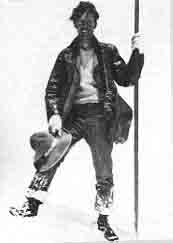Who Was This Halliburton?
Sidebar to: How I Almost Climbed Cheops’ Pyramid

Richard Halliburton, the handsome, romantic, try-anything daredevil of the Roaring 20s, put the dream into young Carey Moore’s head to climb to the top of Cheops’ pyramid.
Halliburton’s exploits around the world—climbing the Great Pyramid, swimming the Hellespont—became the stuff of his travelogues, which thrilled most of the public and left the skeptics appalled.
Critics called much of Halliburton’s writing fiction, saying that he had not done everything he claimed. So Halliburton made a habit of documenting his stunts with photographs. He stood by everything he claimed to have done, but said, “I splash a little red paint on it to make it interesting.”
In 1928, after christening himself the S.S. Halliburton, he paid a toll of 36 cents in order to swim the length of the Panama Canal. Halliburton followed Ulysses’ route round the Mediterranean; stowed away on a ship bound for Singapore; hiked the width of the Malay Peninsula; made the first-ever, midwinter, solo climb of Mt. Fuji; retraced Hannibal’s journey across the Alps, complete with an elephant from the Paris zoo; and faked his own death.
Halliburton was accused of pulling stunts just for publicity. His response? “The world doesn’t really want philosophers and intellects. The world wants escape.”
In the madcap 20s Halliburton’s style fit right in. His first book, The Royal Road to Romance, sold 100,000 copies in 1926. He followed with The Glorious Adventure, another best seller. For his lectures, he earned the impressive sum of $500 a piece. Once, when the tickets sold out, his disappointed fans almost rioted.
Already a library member? Log in here.
Institution user? Log in with your IP address.

